Terashita:
An inland shell midden is investigated. Gorgeous personal ornaments, including a decorated antler section, are recovered in large numbers
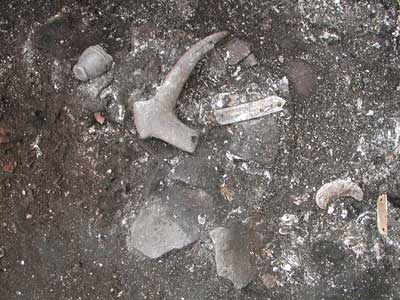 Antler ornament in situ
Antler ornament in situ
A decorated ornament made from a forked antler section was recovered from the top of a stratum yielding human bones. Red painted miniature pottery, the leg of a goggle-wearing human clay figurine, shell bracelets, and ornaments made of wild boar tusk were detected nearby. These were possibly grave goods.
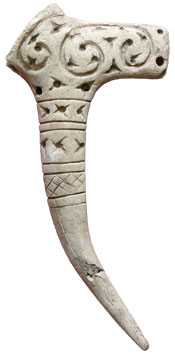
Decorated antler ornament
Using the forked section of a deer antler as the material, the surface was smoothed and decorated with designs. Length 26 cm.
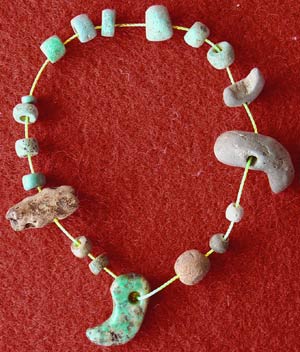
Beads
There are beads made from stone and from clay. Stone beads made of jade and serpentinite have been ascertained. Diameters range from 0.3 - 0.7 cm.
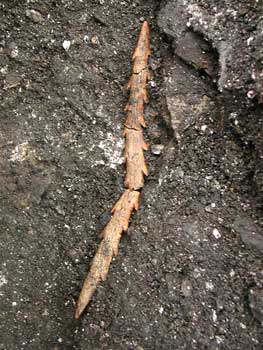 Bone implement in situ
Bone implement in situ
Fishing gear was made from bone and tusk. This photo shows the barbed head of a spear, used for stabbing fish, in situ.
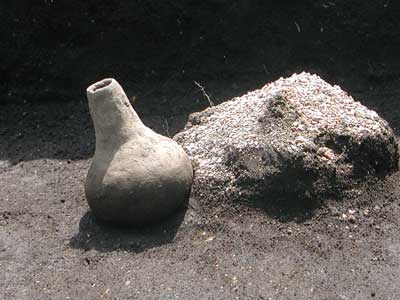
Jar-shaped vessel containing snake bones
|

Clay figurines
|
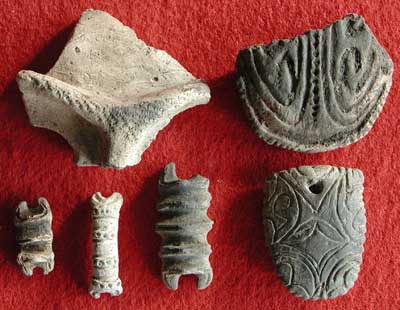
Clay mask (upper left), clay plaques (upper and lower right), caterpillar-shaped clay objects (lower left, three items)
|

Bone and antler implements
|
Terashita Site, Hashikami Town, Aomori Prefecture
Terashita is located in the southeastern portion of Aomori Prefecture, approximately 4.5 km inland from the modern shoreline, on a hilltop roughly 140-170 m above sea level. At this site, dating from the latter half of the Late Jōmon to the start of the Yayoi periods (approximately 4,000ō2,300 years ago), the widened section of a forestry road extending roughly 125 m2 in area was investigated in 2004, with eleven pit-dwellings and eleven pits from the end of the Late Jōmon to the mid Final Jōmon uncovered, along with a shell midden from the mid Final Jōmon period.
The shell midden consists of shells and other materials thought to have been discarded in the depressions of pit dwellings abandoned in the mid Late Jōmon, and in a stream falling off to the north of the site. The bones of land animals, birds, and fish have been detected from the midden along with shells, as well as numerous artifacts fashioned from bone and antler.
Delicately worked personal ornaments, furnished with designs
Among bone and antler implements, there were bone spoons and needles, fishhooks, harpoon and fishing spear heads, arrow-nocks (serving as the tang for an arrowhead), bow-end attachments, and personal ornaments (a decorated forked antler section, necklaces, hair pins, etc.). Spoons and needles are numerous, and while fishing gear was recovered, in the form of fishhooks, and harpoon and fishing spear heads, these items may be characterized as extremely few in number compared with other shell midden sites. After spoons and needles, finely worked and decorated personal ornaments were found in large numbers. The decorated forked antler section was found in near perfect condition. These ornaments are found in graves of this period in the hip region of male skeletons, and are thought to be one of the few personal ornaments worn by men at the time.
Conditions of preservation within the shell midden were extremely good in the current excavation, and as bone and antler implements of the Final Jōmon were recovered, it was possible to obtain valuable materials for considering the living environment, culture, and beliefs of the period. (Mori Atsushi)





